|
बी एड - एम एड >> बी.एड. सेमेस्टर-1 प्रश्नपत्र-IV-B - वैल्यू एण्ड पीस एजुकेशन बी.एड. सेमेस्टर-1 प्रश्नपत्र-IV-B - वैल्यू एण्ड पीस एजुकेशनसरल प्रश्नोत्तर समूह
|
5 पाठक हैं |
||||||
बी.एड. सेमेस्टर-1 प्रश्नपत्र-IV-B - वैल्यू एण्ड पीस एजुकेशन (अंग्रेजी भाषा में)
Question- What is Peace Education?
Answer -
Peace education hopes to create in the human consciousness a commitment to the ways of peace. Just as a doctor learns in medical school how to minister to the sick, students in peace education classes learn how to solve problems caused by violence. Social violence and warfare can be described as a form of pathology, a disease. Peace education tries to inoculate students against the evil effects of violence by teaching skills to manage conflicts nonviolently and by creating a desire to seek peaceful resolutions of conflicts. Societies spend money and resources training doctors to heal the ill. Why should not they also educate their citizens to conduct affairs nonviolently? Peace educators use teaching skills to stop violence by developing a peace consciousness that can provide the basis for a just and sustainable future.
The word ‘education’ comes from the Latin word ‘educare,’ to draw or lead out. Peace education draws out from people their instincts to live peacefully with others and emphasizes peaceful values upon which society should be based. Educators, from early childhood to adult, can use their professional skills to tell their students about peace. The study of peace attempts to nourish those energies and impulses that make possible a meaningful and life-enhancing existence. Peace educators address the violent nature of society, and ask, “Must it be this way?” Aren’t there nonviolent ways that human beings can solve their conflicts? How do we get to these other ways? Just as war has its adherents and its schools, peace can be taught and promoted so that it becomes active in the mind of citizens and world leaders. Traditional education glorifies established power to legitimize its authority. History books praise military heroes and ignore the contributions of peace makers. Violence, carried out by governments waging war and repressing civil rights, also appears in homes where physical and psychological assaults confront conflict, disobedience, anger, and frustration. Children too often learn in school to respect the military and to support those structures that contribute to violence, like violent forms of popular entertainment. They also learn not to question violent political and social behaviour. Peace educators question the structures of violence that dominate everyday life and try to create a peaceful disposition in their students to counteract the omnipotent values of militarism. A European peace educator has defined peace education as: “The initiation of learning processes aiming at the actualization and rational resolution of conflicts regarding man as subject of action.”
According to this definition, peace educators teach peacemaking skills. A Japanese peace educator states that peace education is concerned with peaceless situations (Mushakoji, 1974: 3). These include struggles for power and resources, ethnic conflicts in local communities, child abuse, and wars. Students in peace education classes study institutions that create violence as well as the values that give credibility to those structures. An American peace educator, Betty Reardon, defines peace education as “learning intended to prepare the learners to contribute toward the achievement of peace”. She goes on to state that peace education "might be education for authentic security,” where a need for security motivates humans to form communities and nations. Because individuals disagree about how to achieve security, there are many different paths to peace.
An Israeli educator has stated that peace education programs take different forms because of the wide variety of conflicts that plague human existence. Each different form of violence requires a unique peace education strategy to resolve its conflicts. Peace education in intense conflicts attempts to demystify enemy images and urges combatants to withdraw from warlike behaviour. Peace education in regions of interethnic tension relies upon an awareness about the sufferings of the various groups involved in the conflict to reduce hostilities and promote empathy for the pain of others. Peace educators in areas free from collective physical violence teach about oppression within that society, explain the causes of domestic and civil violence, and develop a respect for global issues, environmental sustainability, and the power of nonviolence. In addition to providing knowledge about how to achieve peace, peace educators promote a pedagogy based upon modeling peaceful democratic classroom practices. They share a hope that through education people can develop certain thoughts and dispositions that will lead to peaceful behaviour. Key aspects of this disposition include kindness, critical thinking, and cooperation. Developing such virtues is an important part of peace education. However, it is not the complete picture.
The struggle to achieve peace takes place at both individual and social levels. Peace educators work with individuals to point how the root problems of violence lie in broader social forces and institutions that must be addressed in order to achieve peace. Peace activists use community education to alert people about the horrors of violence. Working through non-governmental organizations they use public relations techniques — guest speakers, press releases, media interviews, and newsletters — to provide awareness about nonviolent solutions to conflict. Educators from many different academic disciplines also practice peace education. Sociologists in college classrooms talk about violence in civil society. Political scientists describe world order models meant to manage global conflicts. Psychologists explain the structures in the human psyche that lead to violent behaviour. Anthropologists debate about violent and peaceful tendencies of collective human behaviour. Historians write about the history of peace movements. Literature professors review works of art devoted to peace. Professional teachers in primary and secondary schools teach about peace in many settings, from early childhood to high school. Most infuse peace themes into their curriculum while some organize peace studies programs that provide a more comprehensive overview of peace strategies.
|
|||||













